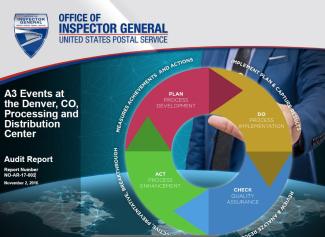A3 Events at the Denver, CO, Processing and Distribution Center
Background
In 2007, the U.S. Postal Service introduced the Continuous Improvement (CI) Program as a management strategy to produce both immediate and sustainable, continuous process improvements for the organization. The Postal Service management uses the Lean Six Sigma, Kaizen, and A3 problem solving processes as part of the CI Program. All three CI processes use the A3 report format, an industry term derived from the 11x17 paper size used for reporting.
The A3 process is a “plan-do-check-act” approach that Postal Service management uses to analyze specific operational deficiencies and identify their root causes.
Between March and July 2016, the Denver, CO, Processing and Distribution Center (P&DC) managers with training in CI principles used the A3 process seven times to reduce the amount of unprocessed First-Class Mail (FCM) on-hand at 3 p.m. The Denver P&DC was required to complete A3s because they were listed in the top 10 of the daily mail condition report as having FCM on-hand at 3 p.m.
The Postal Service has established 3 p.m. as a critical time to complete processing of all destinating FCM to a 5-digit ZIP Code level so that letter carrier delivery point sequencing of the 5-digit mail can begin for the next day’s delivery. When this FCM is on-hand and not processed the risk of delayed mail increases.
The objective of this audit was to evaluate the Postal Service’s compliance with and effectiveness in using the A3 process to eliminate FCM on-hand at 3 p.m. at the Denver P&DC.
What the OIG Found
Denver P&DC management did not comply with A3 process requirements for five of the seven A3 events we reviewed. Specifically, for five A3 events, management used the same general cause of delivery bar code and tray sorter staffing rather than documenting specific root causes for staffing issues. In addition, in four of the A3 events, management did not update the A3 reports to reflect the current conditions of FCM on-hand at 3 p.m.
Noncompliance occurred because management viewed the A3 process as a continuous refinement of ongoing issues instead of an analysis of unique incidents that may have unique root causes.
We did find that management correctly completed two of the A3s for FCM on-hand at 3 p.m.
Because management did not document specific root causes, they were not able to effectively develop specific actions to address delivery barcode and tray sorter staffing issues. In addition, because management did not update the current condition they could not readily identify the gap between the current performance and the desired state of having no unprocessed FCM on-hand at 3 p.m. Management may have been able to fix the problem sooner and sustained the improvements if they had correctly used the A3 process.
While management did not always correctly use the A3 process, the process did help management focus on eliminating the causes of FCM on-hand at 3 p.m. at the Denver P&DC. This category of mail declined from a high of 29 percent of the national volume in April 2016 to 0.3 percent in July 2016.
What the OIG Recommended
We recommended management ensure employees follow the entire A3 process.

